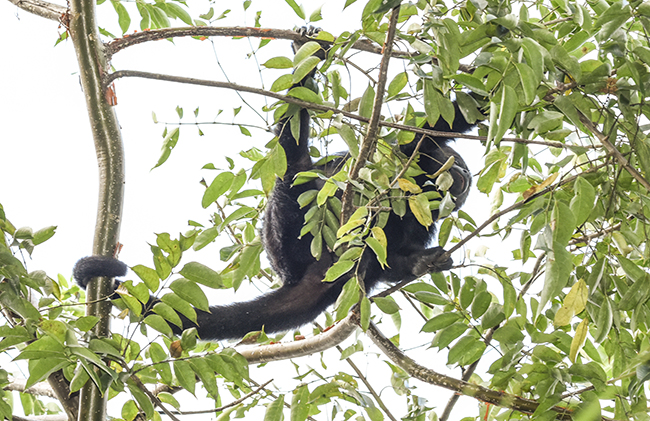Posted December 14, 2015
In 50 years of photographing animals of Guatemala, Mexico, and Belize, I do not have good photographs of howler monkeys. Spider monkeys are easier, especially since AutoSafari Chapin has over a dozen on islands, so they are totally free to wander around (they can even swim to move away from the island if they want to). No cage, so no ugly metal bars in the photograph! Plus I estimate monkeys are happier not being in a cage.
We saw this little guy swinging all over the place. Sometimes you can hear the howl from a 8 Km. of distance.
I have not yet seen any zoo with captive howler monkeys, nor yet met anyone who has a pet howler (though we do know people do keep them). It is best to have animals out in the forests, but for photographic research, it definitely helps if the habitat of the howler is accessible in a realistic manner. We have over a thousand utilitarian plants we need to find and photograph in Guatemala
(www.maya-ethnobotany.org) and hundreds of animals of the Mayan world. So it is not realistic to spend months in mosquito and snake heaven to photograph animals for study purposes.
So it was a pleasant and unexpected surprise to find a howler monkey 6 meters directly above me while I was checking in at the Hotel Ecológico Cabañas del Lago. Using a 200mm lens I was able to get a high-resolution photo (Nikon D810, 36 megapixel camera). So if you seek a howler monkey to photograph, check them out at www.ecoHotelCabanaDeLago.mex.tl
These howlers are not captive! They are in their native habitat (along the shores of Lake Izabal, Guatemala).
Out in the forests, if you are lucky, sometimes you can find a howler monkey close enough to use a telephoto lens. But if you really want good photos it helps to go to Tikal, Yaxha, or comparable places in Mexico (Calakmul perhaps), and Belize. But I lived and worked at Tikal for 12 months (in 1965) and at Yaxha over five years (1970’s) and have been at Calakmul in the 1990’s. Still no really good howler photos, though Las Guacamayas Biological reserve on the Rio San Pedro is a good place. So again, I recommend the Hotel Ecológico Cabañas del Lago.
There are two species: Guatemalan black howler, Alouatta pigra and the golden-mantled howler, Alouatta palliate. I estimate the one I photographed in Izabal is the black howler.
























